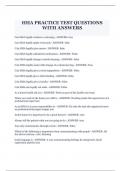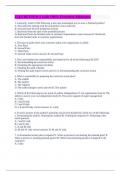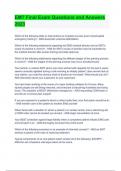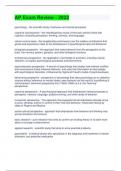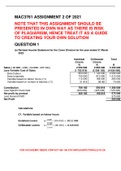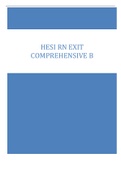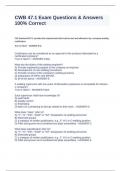CHAPTER 38
Power Series
In Problems 38.1-38.24, find the interval of convergence of the given power series. Use the ratio test, unless otherwise
instructed.
38.1 2 x"/n.
Therefore, the series converges absolutely
for and diverges for When we have the divergent harmonic series E l/n. When
the series is which converges by the alternating series test. Hence, the series converges
for
38.2 E x"/n2.
Thus, the series converges absolute-
ly for and diverges for When * = 1, we have the convergent p-series E l/n 2 . When
*=-!, the series converges by the alternating series test. Hence, the power series converges for -1 s x s 1.
38.3 E*"/n!.
Therefore, the series converges for all x.
38.4 E nix"
(except when x = 0). Thus, the series converges only for
x = 0.
38.5 E x"/2".
This is a geometric series with ratio x/2. Hence, we have convergence for |j;/2|<l, |*|<2, and
divergence for |jc|>2. When x = 2, we have E l , which diverges. When x = -2, we have E(-l)",
which is divergent. Hence, the power series converges for -2 < x < 2.
38.6 Ex"/(rt-2").
Thus, we have convergence for
|*| < 2, and divergence for |jd>2. When x = 2, we obtain the divergent harmonic series. When x = —2.
we have the convergent alternating series E (-l)7n. Therefore, the power series converges for — 2 s j c < 2 .
38.7 E nx".
So we have convergence f&r \x\ < 1, and divergence foi
\x\ > 1. When x = 1, the divergent series E n arises. When x = — 1, we have the divergent series
E (— l)"n. Therefore, the series converges for — l < j t < l .
38.8 E 3"x"/n4".
Thus, we have convergence
for and divergence for For we obtain the divergent series E l/n, and, for
we obtain the convergent alternating series E(-l)"/n. Therefore, the power series converges for
326
, POWER SERIES 327
38.9 E (ax)", a > 0.
So we have convergence for |*| < 1 fa, and divergence for |*| > 1 la. When
x = I / a , we obtain the divergent series E 1, and, when x = — I / a , we obtain the divergent series E (-1)".
Therefore, the power series converges for — l/a<x<l/a.
38.10 E n(x - I)".
A translation in Problem 38.7 shows that the power series converges for 0 < x < 2.
38.11
Thus, we have conver
gence for \x\ < 1, and divergence for |jc| > 1. When x = 1, we get the convergent series E l/(/r + 1)
(by comparison with the convergent p-series E 1/n2); when x = —l, we have the convergent alternating
series E (—l)7(n 2 + 1). Therefore, the power series converges for — 1 s x < 1.
38.12 E (x 4- 2)7Vn.
So we have convergence
for |x + 2|<l, -1<* + 2<1, - 3 < x < - l , and divergence for x<-3 or x>-l. For x =-I,
we have the divergent series E 1/Vn (Problem 37.36), and, for x = -3, we have the convergent alternating
series E (—l)"(l/Vn). Hence, the power series converges for — 3==:e<-l.
38.13
Thus, the power series converges for all x.
38.14
Hence, the power series converges for all x.
38.15
Hence, we have convergence for |*|<1, and divergence for \x\ > 1. For x = l , E l / l n ( r c + l) is di-
vergent (Problem 37.100). For x = -I, E (-l)'Vln (n + 1) converges by the alternating series test. There-
fore, the power series converges for — 1 < x < 1.
38.16 E x"ln(n + 1).
Thus, we have convergence for
\x\ < 1 and divergence for \x\ > 1. When x = ±1, the series is convergent (by Problem 37.10). Hence,
the power series converges for — 1 < x ^ 1.
38.17
Hence, the series converges for all x.
Power Series
In Problems 38.1-38.24, find the interval of convergence of the given power series. Use the ratio test, unless otherwise
instructed.
38.1 2 x"/n.
Therefore, the series converges absolutely
for and diverges for When we have the divergent harmonic series E l/n. When
the series is which converges by the alternating series test. Hence, the series converges
for
38.2 E x"/n2.
Thus, the series converges absolute-
ly for and diverges for When * = 1, we have the convergent p-series E l/n 2 . When
*=-!, the series converges by the alternating series test. Hence, the power series converges for -1 s x s 1.
38.3 E*"/n!.
Therefore, the series converges for all x.
38.4 E nix"
(except when x = 0). Thus, the series converges only for
x = 0.
38.5 E x"/2".
This is a geometric series with ratio x/2. Hence, we have convergence for |j;/2|<l, |*|<2, and
divergence for |jc|>2. When x = 2, we have E l , which diverges. When x = -2, we have E(-l)",
which is divergent. Hence, the power series converges for -2 < x < 2.
38.6 Ex"/(rt-2").
Thus, we have convergence for
|*| < 2, and divergence for |jd>2. When x = 2, we obtain the divergent harmonic series. When x = —2.
we have the convergent alternating series E (-l)7n. Therefore, the power series converges for — 2 s j c < 2 .
38.7 E nx".
So we have convergence f&r \x\ < 1, and divergence foi
\x\ > 1. When x = 1, the divergent series E n arises. When x = — 1, we have the divergent series
E (— l)"n. Therefore, the series converges for — l < j t < l .
38.8 E 3"x"/n4".
Thus, we have convergence
for and divergence for For we obtain the divergent series E l/n, and, for
we obtain the convergent alternating series E(-l)"/n. Therefore, the power series converges for
326
, POWER SERIES 327
38.9 E (ax)", a > 0.
So we have convergence for |*| < 1 fa, and divergence for |*| > 1 la. When
x = I / a , we obtain the divergent series E 1, and, when x = — I / a , we obtain the divergent series E (-1)".
Therefore, the power series converges for — l/a<x<l/a.
38.10 E n(x - I)".
A translation in Problem 38.7 shows that the power series converges for 0 < x < 2.
38.11
Thus, we have conver
gence for \x\ < 1, and divergence for |jc| > 1. When x = 1, we get the convergent series E l/(/r + 1)
(by comparison with the convergent p-series E 1/n2); when x = —l, we have the convergent alternating
series E (—l)7(n 2 + 1). Therefore, the power series converges for — 1 s x < 1.
38.12 E (x 4- 2)7Vn.
So we have convergence
for |x + 2|<l, -1<* + 2<1, - 3 < x < - l , and divergence for x<-3 or x>-l. For x =-I,
we have the divergent series E 1/Vn (Problem 37.36), and, for x = -3, we have the convergent alternating
series E (—l)"(l/Vn). Hence, the power series converges for — 3==:e<-l.
38.13
Thus, the power series converges for all x.
38.14
Hence, the power series converges for all x.
38.15
Hence, we have convergence for |*|<1, and divergence for \x\ > 1. For x = l , E l / l n ( r c + l) is di-
vergent (Problem 37.100). For x = -I, E (-l)'Vln (n + 1) converges by the alternating series test. There-
fore, the power series converges for — 1 < x < 1.
38.16 E x"ln(n + 1).
Thus, we have convergence for
\x\ < 1 and divergence for \x\ > 1. When x = ±1, the series is convergent (by Problem 37.10). Hence,
the power series converges for — 1 < x ^ 1.
38.17
Hence, the series converges for all x.


